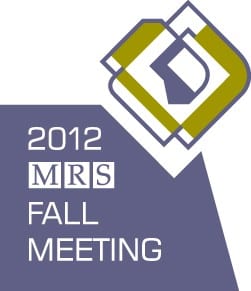 The 2012 Fall Meeting of the Materials Research Society (MRS) took place in Boston, Massachusetts, USA, from November 25 to November 30. With 52 technical symposia, nine tutorials, four poster sessions, more than 250 exhibitors, and 6600 registered participants it was the largest MRS Fall Meeting yet. Divided into the major topical areas “Materials for Energy Technologies”, “Soft Materials and Biomaterials”, “Functional Materials and Nanomaterials”, “Structural and Advanced Materials”, and “Synthesis, Characterization and Modeling Methods”, the symposia reflected the highly interdisciplinary nature of materials science and provided a framework for the participants to present their research and discuss it with their scientific peers.
The 2012 Fall Meeting of the Materials Research Society (MRS) took place in Boston, Massachusetts, USA, from November 25 to November 30. With 52 technical symposia, nine tutorials, four poster sessions, more than 250 exhibitors, and 6600 registered participants it was the largest MRS Fall Meeting yet. Divided into the major topical areas “Materials for Energy Technologies”, “Soft Materials and Biomaterials”, “Functional Materials and Nanomaterials”, “Structural and Advanced Materials”, and “Synthesis, Characterization and Modeling Methods”, the symposia reflected the highly interdisciplinary nature of materials science and provided a framework for the participants to present their research and discuss it with their scientific peers.
Carbon nanomaterials such as carbon nanotubes, fullerenes and mesoporous carbon have attracted considerable interest in the last decades due to their potential applications in nanoscale electronics. This interest has been spurred further since the discovery of graphene, a two-dimensional modification of carbon with intriguing electronic properties that lead to exceptionally high electron mobilities, making this material a prime candidate for replacing silicon as a base material for high-performance electronics.
In the W/WW Tutorial on graphene on Sunday, November 25, the instructors Taiichi Otsuji (Tohoku University, Japan), Pierre Seneor (Thales Group, France), Walt de Heer (Georgia Tech, USA), and Mary B. Chan-Park (Nanyang Technological University, Singapore) introduced, for the non-specialist, the unique physical properties of graphene, as well as its various preparation methods and characterization techniques. In addition, they highlighted graphene’s potential for application, but also addressed the challenges of achieving high-quality synthesis and incorporation into reliable electronic devices.
The scientific discussions on carbon nanomaterials, notably carbon nanotubes and graphene, continued in Symposium W from Monday, November 26, to Friday, November 30, including eminent invited contributions from Pulickel Ajayan (MIT) on the engineering of atomic layers of carbon and other two-dimensional materials, Sungho Jin (University of California, San Diego) on the manipulation of graphene and carbon nanotubes for achieving advanced functionalities, and Mildred Dresselhaus (Kavli Prize on Nanoscience Laureate, MIT) who gave a historical overview of the development of nanocarbon research. Four invited speakers dealt with commercialization issues of graphene, namely Phaedon Avouris (IBM T. J. Watson Research Center), Rod Ruoff (University of Texas, Austin), Michael Capano (Group 4 Development), and Mike Patterson (Graphene Frontiers).
While structural biomaterials, such as titanium-based implants designed to replace bone, are a classical topic in materials science, many research efforts are currently geared towards functional biomaterials and bio-inspired materials, witnessed by the fact that five MRS Fall Meeting Symposia specifically focused on this area. A swiftly evolving line of research is centered on mimicking Nature’s solutions for the development of textured surfaces: in the well-attended Symposium M – Bioinspired Directional Surfaces – emphasis was placed on the preparation, characterization, and application of surfaces with particular functionalities such as repulsion of liquids or the possibility to switch between hydrophobic and hydrophilic behavior.
Joanna Aizenberg (Harvard University) reported on materials that not only repel water, but also more viscous fluids such as oil or heavily staining substances without leaving detectable traces. The key to achieving contact angles close to 180 degrees between drops of liquid and the surface lies in the nanostructuring and subsequent infusing of the surface with a lubricating fluid, a method inspired by the behavior of the Nepenthes pitcher plants. These patented “Slippery Liquid Infused Porous Surfaces” (SLIPS) have a variety of applications, for example as self-cleaning and anti-fouling coatings in building and construction or in marine transportation.
Lei Jiang (Chinese Academy of Sciences) pointed out the importance of understanding the correlation between the typical multiscale structure of a natural biomaterial and its properties on the meso- and macroscale in order to design artificial, bio-inspired materials with desirable properties such as hydrophobicity, transparency or opacity, adhesion, or response to external stimuli.
Karl Boehringer (University of Washington) presented results on the directed motion of liquid droplets on surfaces by texture ratchets. These microstructured regions allow for the precise control of the movement of the drops over relatively long distances up to the centimeter range, even along complicated trajectories such as circular paths, simply by vibrating the surface. As no further external stimuli such as electric fields or pressure gradients are needed for the propulsion of the liquid droplets, texture ratchets provide a low-cost alternative to conventional, microfluidics-based lab-on-a-chip applications.
Any MRS Fall Meeting would be incomplete with award presentations, and this year did not disappoint. The MRS Theory Award was bestowed to John Perdew “for his pioneering contributions to the fundamental development and nonempirical approximations in density functional theory” (from the laudation). In his award talk “Climbing the Ladder of Density Functional Approximations” he outlined the basics of density functional theory, the most widely-used method of electronic structure calculation in materials science and quantum chemistry. He surveyed the development of energy functionals that allow for the increasingly more accurate incorporation of exchange-correlation effects, coming from the local density approximation over the generalized gradient approximation up to the random-phase approximation. Most of the quantum-mechanical effects that govern the behavior of electrons in solids and in molecules can be captured by these methods which are implemented in ready-to-use, high-performance computer programs, but, as Perdew says, “much work remains to be done to make these approximation even more accurate”.
The first MRS Medal was awarded to Jennifer Lewis (University of Illinois at Urbana-Champaign) “for pioneering contributions in the design of viscoelastic inks composed of colloidal, polymeric, and organometallic building blocks and their directed assembly into planar and 3D functional architectures”, and the second to Miquel Salmeron (Lawrence Berkeley National Laboratory) “for his contribution to the molecular level understanding of material surfaces under ambient conditions of gas pressure and temperature made possible by the development and application of Ambient Pressure Photo-Electron Spectroscopy (APPES), which revealed the chemical structure of liquids, catalysts surfaces and nanoparticles during environmental reaction conditions”.
The recipient of the David Turnbull Lectureship Award was Robert Sinclair (Stanford University) “for his original contributions to the understanding of atomic arrangements in solids and their relationship to diverse materials phenomena including martensitic transformations, dislocation interactions with interfaces, phase equilibria in complex thin film systems, and nanoscale interaction in soft matter, for seminal contributions to in situ and high resolution transmission electron microscopy, development of their combined use, and for passionate and dedicated teaching, advising, and academic leadership”.
The MRS’s highest honor, the Van Hippel Award, was conferred to Stuart Parkin (IBM Almaden Research Center) “for pioneering contributions to the science and technology of spintronic materials, particularly in establishing the fundamental foundations of spin-engineered magnetic heterostructures and demonstrating artificial atomically-layered magnetic multilayers for applications in field sensing, magnetic memory and data storage devices”.
The 2012 MRS Fall Meeting showed again that materials science is as vibrant as ever, providing insight into fundamental scientific questions, laying the foundation for the commercialization of materials, and proposing solutions to some of society’s most pressing matters such as energy demand and sustainability. We can therefore already look forward to the next instalment of the MRS Fall Meeting in Boston in December 2013 and, to bridge the time, to the forthcoming MRS Spring Meeting in San Francisco in April 2013.














